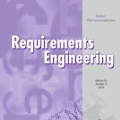The boundary conditions (BCs) have shown great potential in requirements engineering because a BC captures the particular combination of circumstances, i.e., divergence, in which the goals of the requirement cannot be satisfied as a whole. Existing researches have attempted to automatically identify lots of BCs. Unfortunately, a large number of identified BCs make assessing and resolving divergences expensive. Existing methods adopt a coarse-grained metric, generality, to filter out less general BCs. However, the results still retain a large number of redundant BCs since a general BC potentially captures redundant circumstances that do not lead to a divergence. Furthermore, the likelihood of BC can be misled by redundant BCs resulting in costly repeatedly assessing and resolving divergences. In this paper, we present a fine-grained metric to filter out the redundant BCs. We first introduce the concept of contrasty of BC. Intuitively, if two BCs are contrastive, they capture different divergences. We argue that a set of contrastive BCs should be recommended to engineers, rather than a set of general BCs that potentially only indicates the same divergence. Then we design a post-processing framework (PPAc) to produce a set of contrastive BCs after identifying BCs. Experimental results show that the contrasty metric dramatically reduces the number of BCs recommended to engineers. Results also demonstrate that lots of BCs identified by the state-of-the-art method are redundant in most cases. Besides, to improve efficiency, we propose a joint framework (JAc) to interleave assessing based on the contrasty metric with identifying BCs. The primary intuition behind JAc is that it considers the search bias toward contrastive BCs during identifying BCs, thereby pruning the BCs capturing the same divergence. Experiments confirm the improvements of JAc in identifying contrastive BCs.
翻译:边界条件( BCs) 在需求工程中显示出巨大的潜力,因为 BC 捕捉了特定环境组合的多余的 BC, 即差异, 无法整体满足要求的目标。 现有的研究试图自动识别大量 BCs 。 不幸的是, 大量已查明的 BCs 使得评估和解决差异变得昂贵。 现有方法采用粗化的衡量标准, 笼统, 过滤不那么一般的 BCs 。 但是, 结果是大量多余的 BCs, 因为一般的 BC 可能捕捉不导致差异的多余情况。 此外, 重复的 BCs 可能会被重复的 BCs 误差所误导, 导致反复评估和解决差异。 在本文件中, 我们提出了一个精细的衡量标准, 过滤多余的 BCs 。 如果两个 BCsals 具有对比性, 就会捕捉到不同的差异。 我们认为, 一组对比性的 BCSBs, 而不是一套可能显示差异的通用 BCsalds 。 然后, 我们提出一个后级的BCalalal 格式框架, 显示一个比 。



